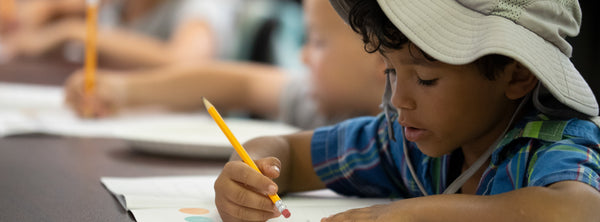
Top 5 Trends in Virtual Reality for Education
Virtual reality (VR) is no longer a futuristic concept. It’s actively reshaping education by making learning more interactive, engaging, and hands-on.
Schools and universities are using VR to bridge the gap between theory and practice, allowing students to explore science, history, and technology in fully immersive environments.
From virtual field trips to teaching students how to design their own VR applications, the role of virtual reality in education continues to grow. But what are the most effective ways VR is being used in classrooms today?
Here are five of the biggest trends in VR education and why they matter.
1. Hands-On STEM Learning Through Immersive Simulations
One of the biggest challenges in STEM education is providing students with real-world, hands-on experiences—especially when working with expensive lab equipment, hazardous materials, or complex engineering concepts.
VR eliminates these barriers by allowing students to conduct experiments, build models, and explore scientific concepts in a risk-free, virtual environment.
For example:
- Physics students can experiment with gravity, friction, and motion in a virtual physics lab, adjusting variables in real time and observing the outcomes.
- Biology students can virtually dissect organisms without the ethical or financial constraints of traditional dissections.
- Chemistry students can safely mix chemicals in VR without worrying about dangerous reactions.
A study published in Computers & Education found that students who used VR for STEM learning scored 76% higher on conceptual understanding tests compared to students using traditional learning methods. The ability to interact with complex systems in a fully immersive environment allows students to grasp difficult concepts more effectively than with textbooks or videos alone.
Why It Matters:
- Provides hands-on experience in STEM subjects without requiring physical lab space.
- Allows students to experiment safely with real-world scientific principles.
- Improves concept retention and understanding of complex topics.
VR is making STEM education more accessible, engaging, and impactful, giving students the tools they need to succeed in science, technology, engineering, and mathematics.
2. Teaching Students to Design for Virtual Reality
As VR technology becomes more widely used in industries like healthcare, architecture, engineering, and entertainment, the demand for VR designers and developers is growing rapidly. Schools are now integrating VR development courses into their curriculum, teaching students how to create interactive VR experiences instead of just consuming them.
Designing for VR involves multiple disciplines, including:
- 3D modeling and animation – Creating realistic environments and interactive objects.
- Programming and scripting – Writing the code that controls movement, interaction, and game mechanics.
- User experience (UX) design – Ensuring that virtual environments are intuitive and easy to navigate.
- Physics and world-building – Designing how objects behave and interact in a VR space.
By incorporating VR creation tools like Blocksmith, Unity, Unreal Engine, and WebXR, students can build and test their own virtual worlds, preparing them for careers in software development, simulation design, and digital media.
According to PwC's "Seeing is Believing" report, augmented and virtual reality (AR/VR) technologies are projected to impact over 23 million jobs globally by 2030 (PwC, 2019). Schools that teach students how to develop VR applications are giving them a competitive edge in one of the fastest-growing industries today.
Why It Matters:
- Introduces students to in-demand career skills in game design, simulation, and interactive media.
- Teaches students to be creators, not just consumers, of digital experiences.
- Encourages problem-solving, creativity, and technical literacy.
VR is not just about using technology. It’s about learning to build the technology of the future.
3. Virtual Field Trips and Exploratory Learning
Field trips are one of the most effective ways to engage students, but they’re often limited by cost, location, and logistics.
VR removes these barriers by allowing students to visit historical landmarks, explore natural wonders, and even travel to space—all from the classroom.
For example:
- Students studying ancient history can walk through the ruins of Pompeii, experiencing the city as it was before Mount Vesuvius erupted.
- Geography students can hike through the Amazon rainforest or climb Mount Everest without ever leaving school.
- VR even allows for underwater exploration, where students can swim alongside marine life in coral reef ecosystems.
A study by EdTech Magazine found that students who used VR field trips retained 40% more information than those who learned through traditional classroom instruction. The immersive nature of VR makes experiences more memorable and engages students on a deeper level.
Why It Matters:
- Removes financial and logistical barriers to traditional field trips.
- Provides real-world experiences that textbooks and videos cannot.
- Increases student engagement and retention of information.
With VR, the world becomes the classroom, giving students unparalleled access to places and experiences that were once out of reach.
4. Hands-On Career Training and Technical Skills Development
Many industries rely on VR for training, and schools are beginning to adopt these same techniques to prepare students for technical careers. From welding and construction to medical training and aviation, VR is helping students develop hands-on skills in a virtual setting before applying them in the real world.
For example:
- Students training to become electricians or HVAC technicians can practice wiring and repairing systems in VR, reducing the risk of injury while gaining real-world experience.
- Automotive students can assemble and disassemble engines in a virtual garage.
- Future surgeons can practice medical procedures using VR simulations before ever working on a real patient.
A report by PwC found that VR-based training improves learning speed by up to 400% compared to traditional methods, making it one of the most effective ways to teach technical and procedural skills.
Why It Matters:
- Helps students gain hands-on experience in career-focused fields.
- Allows for safe, controlled training environments where mistakes can be made without consequences.
- Reduces the cost of training materials and equipment.
As industries continue to adopt VR training, schools that integrate VR career programs will better prepare students for skilled professions in the modern workforce.
5. Mixed Reality Classrooms and the Future of Hybrid Learning
While VR offers fully immersive environments, mixed reality (MR) or augmented reality (AR) blends virtual and real-world elements, making it easier to integrate into everyday classrooms.
With MR, students can:
- Overlay 3D models onto their physical desks, allowing them to interact with digital content in real space.
- Work on collaborative projects where virtual and real-world elements merge.
- Conduct hands-on science experiments without requiring expensive lab equipment.
A study from Harvard Business Review found that mixed reality improves knowledge retention by 70% compared to traditional learning methods. Schools are using MR for everything from engineering and physics demonstrations to medical training and design projects.
Why It Matters:
- Blends virtual and real-world learning, making VR more practical for daily use.
- Enhances collaboration and engagement in group activities.
- Prepares students for a future where mixed reality is integrated into many industries.
The future of education isn’t just VR. It’s the seamless integration of digital and physical learning environments.
Bringing VR to Your Classroom
Virtual reality isn’t just a trend. It’s transforming how students learn. From STEM education and technical training to virtual field trips and hands-on career preparation, VR is giving students new ways to explore, create, and interact with the world around them.
To successfully implement VR in the classroom, schools should:
- Invest in scalable VR tools that align with existing curriculum goals, such as Game Design, a STEM program for grades 4-12.
- Train teachers to effectively use VR in their lesson plans.
- Ensure access for all students through school-supported devices and software.
As VR technology continues to evolve, educators that embrace immersive learning today will be preparing students for the careers and opportunities of tomorrow.
Ready to Start Your Own Game-Based Learning Program?
From esports to game development and beyond, tapping into students' interests increases engagement and excitement for learning!
Subscribe for Free STEM Resources!


Author: Grant Hathaway
Co-founder of STEM Forged and a passionate advocate for innovative STEM education. With over a decade of experience, Grant is dedicated to empowering educators and inspiring students through hands-on, game-based learning experiences.








